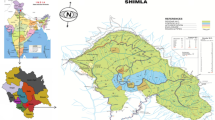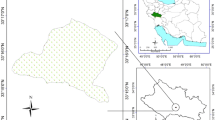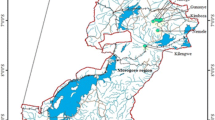Abstract
This study describes diversity patterns in the flora of the Campo-Ma’an rain forest, in south Cameroon. In this area, the structure and composition of the forests change progressively from the coastal forest on sandy shorelines through the lowland evergreen forest rich in Caesalpinioideae with Calpocalyx heitzii and Sacoglottis gabonensis, to the submontane forest at higher elevations and the mixed evergreen and semi-deciduous forest in the drier Ma’an area. We tested whether there is a correlation between tree species diversity and diversity of other growth forms such as shrubs, herbs, and lianas in order to understand if, in the context of African tropical rain forest, tree species diversity mirrors the diversity of other life forms or strata. Are forests that are rich in tree species also rich in other life forms? To answer this question, we analysed the family and species level floristic richness and diversity of the various growth forms and forest strata within 145 plots recorded in 6 main vegetation types. A comparison of the diversity within forest layers and within growth forms was done using General Linear Models. The results showed that tree species accounted for 46% of the total number of vascular plant species with DBH ≥1 cm, shrubs/small trees 39%, climbers 14% and herbs less than 1%. Only 22% of the diversity of shrubs and lianas could be explained by the diversity of large and medium sized trees, and less than 1% of herb diversity was explained by tree diversity. The shrub layer was by far the most species rich, with both a higher number of species per plot, and a higher Shannon diversity index, than the tree and the herb layer. More than 82% of tree species, 90% of shrubs, 78% of lianas and 70% of herbaceous species were recorded in the shrub layer. Moreover, shrubs contributed for 38% of the 114 strict and narrow endemic plant species recorded in the area, herbs 29%, trees only 20% and climbers 11%. These results indicate that the diversity of trees might not always reflect the overall diversity of the forest in the Campo-Ma’an area, and therefore it may not be a good indicator for the diversity of shrubs and herbaceous species. Furthermore, this suggests that biodiversity surveys based solely on large and medium sized tree species (DBH ≥0cm) are not an adequate method for the assessment of plant diversity because other growth form such as shrubs, climbers and herbs are under-represented. Therefore, inventory design based on small plots of 0.1 ha, in which all vascular plants with DBH ≥1 cm are recorded, is a more appropriate sampling method for biodiversity assessments than surveys based solely on large and medium sized tree species.
Similar content being viewed by others
References
Achoundong G. 2000. Les Rinorea et l’étude des refuges forestiers en Afrique. In: Servant M. and Servant-Vildary S. (eds), Dynamique à long terme des écosystèmes forestiers intertropicaux, pp. 19–29.
Balslev H., Valencia R., Paz y Mino G., Christensen L.B. and Nielsen I. 1998. Species count of vascular plants in one hectare of humid lowland forest in Amazonian Ecuador. In: Dallmeier F. and Comiskey J.A.(eds) in Forest Biodiversity in NorthCentral and South Americaand the Caribbean. MAB series, 21: 585–594.
Bisby F.A. 1995. Characterization of biodiversity. In: Heywood V.H. and Watson R.T. (eds), Global Biodiversity Assessment. UNEP, Cambridge University Press, pp. 192–294.
S. Cable M. Cheek (1998) The plants of Mount Cameroon. A Conservation Checklist Royal Botanic Gardens Kew
R. Condit P.S. Ashton P. Baker S. Bunyavejchewin S. Gunatilleke N. Gunatilleke S.P. Hubbell R.B. Foster A. Itoh J.V. LaFrankie S.H. Lee E. Losos N. Manokaran R. Sukumar T. Yamakura (2000) ArticleTitleSpatial patterns in the distribution of tropical tree species Science 228 1414–1417 Occurrence Handle10.1126/science.288.5470.1414
Davis S.D., Heywood V.H. and Hamilton A.C. 1994. Centres of Plant Diversity. A Guide and Strategy for Their Conservation 1.
de Kam M., Fines J.-P. and Akogo G.(eds) 2002. Schéma Directeur pour le developpement de l’Unité Technique Opérationnelle de Campo-Ma’an. Cameroun. Campo-Ma’an Series 1.
J.F. Duivenvoorden J.M. Lips (1995) A Land Ecological Study of Soils, Vegetation and Plant Diversity in Colombia Amazonia The Tropenbos Foundation Wageningen
ERE Développement 2002. Etude socio-économique dans l’UTO de Campo-Ma’an. Rapport final phase 2: résultats d’enquètes auprès des ménages. SNV/Projet Campo-Ma’an.
A. Franqueville (1973) Atlas Regional Sud-Ouest 1. République du Cameroun ORSTOM Yaoundé, Cameroun
Gartlan J.S. 1989. La conservation des ecosystemes forestiers du Cameroun. IUCN.
A.H. Gentry (1988a) ArticleTitleChange in plant community diversity and floristic composition on environmental and geographical gradients Annals of the Missouri Botanical Garden 75 1–34 Occurrence Handle10.2307/2399464
A.H. Gentry (1988b) ArticleTitleTrees species richness of upper Amazonian forests Proceedings of the National Academy of Science USA 85 156–159 Occurrence Handle10.1073/pnas.85.1.156
A.H. Gentry C. Dodson (1987) ArticleTitleContribution of non trees to species richness of a tropical rain forest Biotropica 19 149–156 Occurrence Handle10.2307/2388737
A.C. Hamilton (1982) Environmental History of Africa: A Study of the Quaternary Academic Press London
T.B. Hart J.A. Hart P.G. Murphy (1989) ArticleTitleMonodominant and species-rich forests of the humid tropics: causes for their co-occurrence The American Naturalist 133 613–633 Occurrence Handle10.1086/284941
S.P. Hubbell R.B. Foster (1983) Diversity of canopy trees in a neotropical forest and implications for conservation S.L. Sutton T.C. Whitemore A.C. Chadwick (Eds) Forest: Ecology and Management Blackwell Science Oxford 24–41
S.P. Hubbell R.B. Foster (1986c) Commonness and rarity in a neotropical forest: implications for tropical tree conservation M.E. Soule (Eds) Conservation Biology: The Science of Scarcity and Diversity Sinauer Associates Massachusetts 205–231
M. Kent P. Coker (1992) Vegetation Description and Analysis Belhaven Press London
Koubouana F. 1993. Les forêts de la vallée du Niari, Congo: Etudes floristiques et structurales. Thèse de doctoratUniversité de de Paris 6.
Lejoly J. 1995a. Biodiversité végétale dans le Parc National d’Odzala, Congo. Rapport technique. Groupement Agreco-CTFT.
J. Lejoly (1995b) Utilisation de la méthode de transects en vue de l’étude de la biodiversité dans la zone de conservation de la forêt de NgottoRépublique Centrafricaine Rapport technique Projet ECOFAC Agreco-CTFT
R. Letouzey (1968) Etude phytogéographique du Cameroun Le Chevalier Paris
R. Letouzey (1985) Notice de la carte phytogéographique du Cameroun NumberInSeriesvol. 1–5 Institut de la Carte Internationale de la Végétation Toulouse
A.E. Magurran (1988) Ecological Diversity and its Measurement Croom Helm London
J. Maley (1987) ArticleTitleFragmentation de la forêt dense humide Africaine et extention des biotopes montagnards du Quaternaire recent Paleoecology of Africa 18 307–309
J. Maley (1989) Late Quaternary climatic changes in the African rainforest: the question of forest refuges and the major role of sea surface temperature variations M. Lewen M. Sarthein (Eds) Paleoclimatology and Paleometeology: Modern and Past Patterns of Global Atmospheric Transport Kluwer London 585–616
Mosango M. 1990. Contribution à l’étude botanique et biogéochimique de l’écosystème des forêts en région équatoriale (Ile KongoloZaire). Thèse de doctorat, Université Libre de Bruxelles.
Muller J.P. 1979. Carte des sols du Cameroun. Atlas de la République Unie du Cameroun.
J. Nabe-Nielson (2001) ArticleTitleDiversity and distribution of lianas in a neotropical rain forestYasuni National Park, Ecuador Journal of Tropical Ecology 17 1–19 Occurrence Handle10.1017/S0266467401001018
D. Mc Newbery J.S. Gartlan (1996) ArticleTitleA Structural Analysis of Rainforest at Korup and Douala-EdeaCameroon Proceedings of the Royal Society of Edinburg 104B 177–224
M.P.E Parren (2003) Lianas and logging in West Africa Wageningen University The Netherlands
A.D. Poulsen H. Balslev (1991) ArticleTitleAbundance and cover of ground herbs in an Amazonian rain forest Journal of Vegetation Science 2 315–322 Occurrence Handle10.2307/3235922
F.E Putz P. Chai (1987) ArticleTitleEcological studies of lianas in Lambir National Park, Sarawak, Malaysia Journal of Ecology 75 523–531
Reitsma J.M. 1988. Forest vegetation in Gabon. Tropenbos Technical Series 1.
E. Robbrecht (1996) Geography of African Rubiaceae with reference to glacial rain forest refuges L.J.G. Maesen Particlevan der X.M. Burgt Particlevander J.M. Medenbach de Rooy Particlevan (Eds) The Biodiversity of African Plants Kluwer Academic Publishers Wageningen 564–581
B. Rollet (1974) ArticleTitleLa régénération naturelle dans les trouées Un processus général de la dynamique des forêts tropicales humides Revue Bois et Forêts des Tropiques 201 3–34
S.A. Schnitzer F. Bongers (2002) ArticleTitleThe ecology of lianas and their role in forests Trend in Ecology and Evolution 17 223–230 Occurrence Handle10.1016/S0169-5347(02)02491-6
D. Sheil S. Jennings P. Savill (2000) ArticleTitleLong-term permanent plot observations of vegetation dynamic in Budongoa Ugandan rain forest Journal of Tropical Ecology 16 765–800 Occurrence Handle10.1017/S0266467400001723
Sonké B. 1998. Etudes floristiques et structurales des forêts de la Reserve de Faune de Dja, Cameroun. Thèse présentée en vue de l’obtention du grade de Docteur en sciences, option écologie végétale. Université Libre de Bruxelles
B. Sonké J. Lejoly (1998) Biodiversity study in the Dja Fauna Reserve (Cameroon): using the transect method C.R. Huxley J.M. Lock D.F. Cutler (Eds) Chorology, Taxonomy and Ecology of the Floras of Africa and Madagascar Royal Botanical Gardens Kew 171–179
Sosef M.S.M. 1994. Refuge Begonias. Taxonomy, phylogeny and historical biogeography of Begonia sect. Loasibegonia and sect. Scutobegonia in relation to glacial rain forest refuges in Africa, PhD Thesis, Wageningen Agricultural University.
M.S.M. Sosef (1996) Begonias and African rain forest refuges: general aspects and recent progress L.J.G. Maesen Particlevan der X.M. Burgt Particlevan der J.M. Medenbach de Rooy Particlevan (Eds) The Biodiversity of African Plants Kluwer Academic Publishers Wageningen 602–611
Tchouto M.G.P. 2004. Plant diversity in a Central African rain forest: implications for biodiversity conservation in Cameroon. PhD Thesis, Wageningen University.
ter Steege H. 2000. Plant diversity in Guyanawith recommendations for a National Protected area strategy. Tropenbos Series 18.
R. Valencia H. Balslev G. Pazy Mino (1994) ArticleTitleHigh tree alpha-diversity in Amazonian Ecuador Biodiversity and Conservation 3 21–28 Occurrence Handle10.1007/BF00115330
T. van Andel (2001) ArticleTitleFloristic composition and diversity of mixed primary and secondary forests in northwest Guyana Biodiversity and Conservation 10 1645–1682 Occurrence Handle10.1023/A:1012069717077
van Gemerden B.S. and Hazeu G.W. 1999. Landscape ecological survey (1:100,000) of the Bipindi-Akom II-Lolodorf region, Southwest Cameroon. Tropenbos-Cameroon Document 1.
J.L.C.H. van Valkenburg P. Ketner C.M. Wilks (1998) ArticleTitleA floristic inventory and preliminary vegetation classification of the mixed semi-evergreen rain forest in the Minkébé region, North East Gabon Adansonia 20 139–162
F. White (1983) The Vegetation of Africa UNESCO Paris
White L.J.T. 1996. Determinants of vegetation composition in the Lopé Reserve. Report to AGRECO/CTFT, Gabon.
R.J. Whittaker (1975) Communities and Ecosystems EditionNumber2 Macmillan London
Wolter F. 1993. Etude des possibilités techniques, économiques et financières d’un aménagement des forêts tropicales denses humides de la cuvette centrale du Zaïre, basée sur ses capacités naturelles. Thèse de doctorat. Université de Louvain.
Author information
Authors and Affiliations
Corresponding author
Rights and permissions
About this article
Cite this article
Tchouto, M.G.P., De Boer, W.F., De Wilde, J.J.F.E. et al. Diversity Patterns in the Flora of the Campo-Ma’an Rain Forest, Cameroon: Do Tree Species Tell it All?. Biodivers Conserv 15, 1353–1374 (2006). https://doi.org/10.1007/s10531-005-5394-9
Received:
Accepted:
Issue Date:
DOI: https://doi.org/10.1007/s10531-005-5394-9




